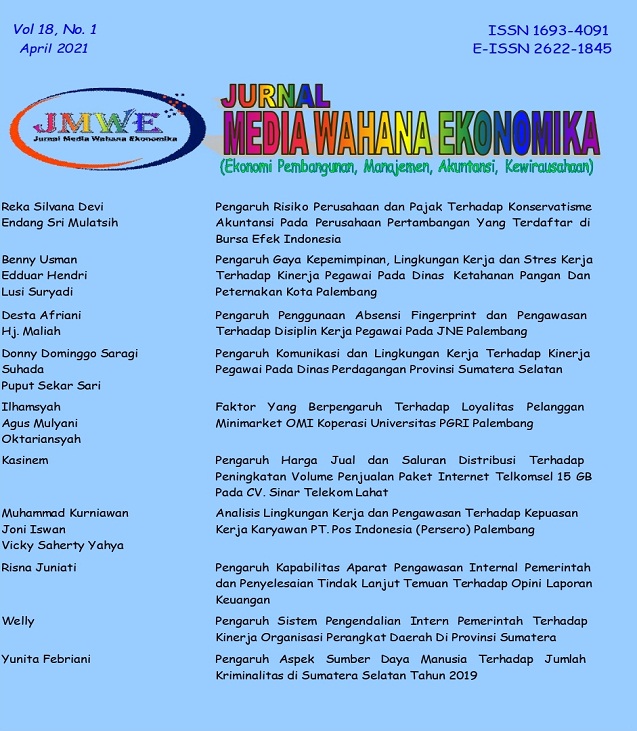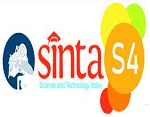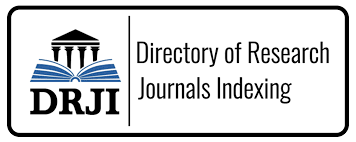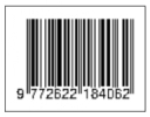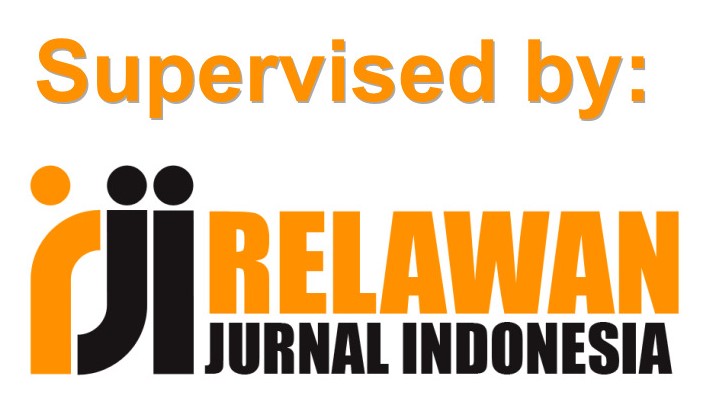Faktor Yang Berpengaruh Terhadap Loyalitas Pelanggan Minimarket OMI Koperasi Universitas PGRI Palembang
DOI:
https://doi.org/10.31851/jmwe.v18i1.5589Abstract
ABSTRAK
Â
Tujuan penelitian untuk mengetahui faktor pelayanan (X1), barang yang ditawarkan (X2), suasana (X3) dan harga (X4) yang berpengaruh terhadap loyalitas pelanggan (Y) serta faktor yang paling dominan terhadap loyalitas pelanggan sebagai variabel terikat. Populasi dihitung melalui rata-rata jumlah pelanggan setiap bulannya yaitu 1.244 sedangkan sampel menggunakan Metode Accidental Sampel sebanyak 97, teknik pengumpulan data adalah kuesioner dan wawancara. Dengan cara menyebar angket dan bertanya secara secara langsung kepada konsumen. Pengujian Instrumen yaitu uji validitas instrumen, uji reliabilitas. Metode analisis yaitu uji normalitas data, uji model terdiri uji heteroskedastisitas. uji multikolinieritas, Model Analisis yaitu analisis jalur yang dihitung dengan dua persamaan struktural yaitu persamaan regresi yang menunjukkan hubungan yang dihipotesiskan, uji koefisien untuk melihat tingkat signifikansi masing-masing koefisien regresi. Hasil Penelitian ini nantinya berapa besar pengaruh faktor signifikan terhadap loyalitas pelanggan dan faktor yang dominan terhadap loyalitas pelanggan di Minimarket OMI Koperasi Univ. PGRI Palembang.
Kata kunci: Pelayanan, Barang, Suasana, Harga, Loyalitas Pelanggan
Â
Â
ABSTRACT
Â
The research objective was to determine the service factor (X1), goods offered (X2), atmosphere (X3) and price (X4) which affect customer loyalty (Y) as well as the most dominant factor on customer loyalty as the dependent variable. The population was counted by the average number of customers each month, namely 1,244, while the sample used the Accidental Method. The sample was 97, the data collection techniques were questionnaires and interviews. By distributing questionnaires and asking directly to consumers. Instrument testing, namely the instrument validity test, reliability test. The method of analysis is the data normality test, the model test consists of the heteroscedasticity test. multicollinearity test, Analysis Model, namely path analysis calculated by two structural equations, namely the regression equation which shows the hypothesized relationship, the coefficient test to see the significance level of each regression coefficient. The results of this study will be how much the influence of significant factors on customer loyalty and dominant factors on customer loyalty in Minimarket OMI Koperasi Univ. PGRI Palembang.
Â
Keywords: Service, Goods, Atmosphere, Price, Customer LoyaltReferences
Alqifari. 2016. Statistik Induktif, Jakarta: UPP STIM YKPN
Berman, B & Evans, Jr 2017 Retail Manajemen: A Strategic Approach . Prentice Hall
Creswell & John, W. 2013 Research Desaign Qualitative & Quantitative Approaches, Jakarta: Penerbit KIK Press
Griffin, Jill. 2015. Customer Loyality: Menumbuhkan Dan Mempertahankan Kesetiaan Pelanggan. Jakarta: Erlangga
Hendri, Ma’ruf , 2015, Pemasaran Ritel, PT. Gramedia Pustaka Utama, Jakarta.
Kotler, P. 2017. Dasar-dasar Pemasaran. Edisi 9 Jilid 1 dan 2. Jakarta. Indonesia:PT.Indeks Kelompok Gramedia
………….., 2012. yang di terjemahkan oleh AB. Susanto, 2012. Manajemen Pemasaran, PT. Prenhalindo, Yogyakarta.
Riadi, Edi, 2016, Statistik Penelitian Analisis Manual Dan IBM SPSS, Yogyakarta: Andi
Sugiyono. (2017). Statistik untuk Penelitian. (cetakan.20). Bandung, Indonesia: Alfa Beta.
Supranto. M.A. 2016. Pengukuran Tingkat Kepuasan Pelanggan Untuk Menaikkan Pangsa Pasar. Jakarta: Rineka Cipta.
…………..., 2015, Dinamika Pemasaran, PT. Raja Grafindo Persada, Jakarta
Tjahyadi, RA. 2016. Brand Trust Dalam Konteks Loyalitas Merek: Peran Karakter Merek. Jurnal Manajemen, 6:65-78
Yavas, U & Babakus, E. 2013. Retail Store Loyalty: A Comparison of Two Customer Segments: International Journal of Retail and Distribution Manajemen, 37:6:477-492
Downloads
Published
Issue
Section
License
The copyright of the received article shall be assigned to the publisher of the journal licensed under a Creative Commons Attribution-NonCommercial 4.0 International License in line with the license, authors and any users (readers and other researchers) are allowed to share and adapt the material only for non-commercial purposes. In addition, the material must be given appropriate credit, provided with a link to the license, and indicated if changes were made. If authors remix, transform or build upon the material, authors must distribute their contributions under the same license as the original.

